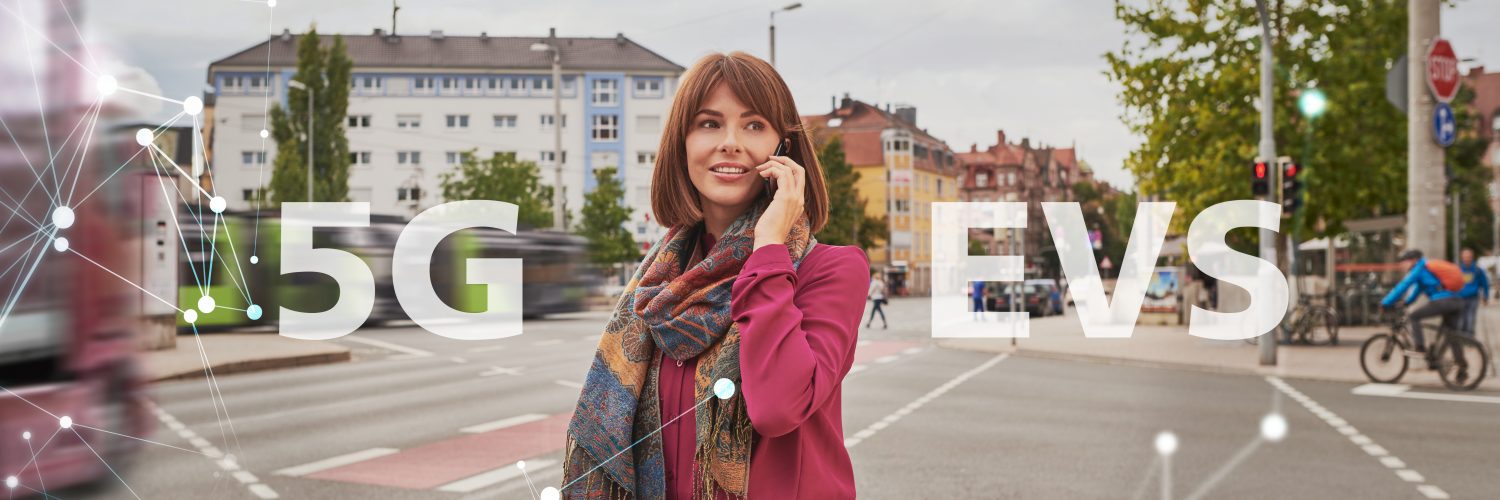Fraunhofer’s Enhanced Voice Services (EVS) communication codec improves voice quality in mobile networks.
The 5G mobile communications standard has been gaining momentum since 2019. As its use progresses, the 2G (GSM) and 3G (UMTS) networks will be switched off successively. In addition to increased frequency capacity (and thus faster data transmission) and reduced latency, 5G is also expected to enable greatly improved voice services.
Fraunhofer IIS technology makes a contribution to this: the Enhanced Voice Services (EVS) communication codec is specifically tailored to 4G and 5G voice services. It noticeably improves the robustness and quality of mobile phone calls. In contrast to the Adaptive Multi-Rate (AMR) and AMR-Wideband codecs still widely used today, EVS enables transmission of the full audible audio bandwidth. Its 16 kHz bandwidth ensures very natural speech sound and excellent intelligibility.
Robust conversations under difficult conditions
EVS also improves the robustness of transmission: especially in and between buildings, that is, predominantly in urban areas, concrete walls and metal coatings can impair call quality and even cause connections to fail or to break off. EVS allows stable calls to be maintained for longer, even under such difficult conditions, thanks to features such as the “channel aware mode”, which reduces the audible effects of poor reception. For this purpose, each new data packet is accompanied by the essential information of past packets. If a data packet is lost, the information it contained can therefore be reconstructed from subsequent packets. This feature supports EVS’s error concealment technology perfectly.
Nevertheless, it may occasionally happen that data cannot be reconstructed. This is when the concealment technology typically comes into play, compensating for lost data packets and ensuring that call quality is maintained. A complex algorithm is used for this purpose, which has been significantly enhanced in EVS compared with predecessor technologies.
EVS specified in GSMA documents as of 5G
Most cell phones that support 4G voice services are also EVS-capable. This means that, in principle, it is possible to use EVS in 4G networks for the highest call quality. To ensure that the technology is now used universally in 5G voice services, the Groupe Spécial Mobile Association (GSMA) made EVS implementation in 5G-capable devices mandatory last year through its “IMS Profile for Voice, Video and Messaging over 5GS” (NG.114). Fraunhofer IIS supported this process with its comprehensive expertise as the world’s leading application-oriented research institution. As a result, network operators can now be confident that cell phones will be EVS-enabled and will reliably support the 5G standard in the future. This makes the switch attractive for network operators around the world. Especially in areas with very high network utilization, where only low data rates can be used, EVS means robust and high-quality voice services will still be possible. Especially for this purpose, EVS can even operate at data rates starting as low as 5.9 kbit/s. Of course, it also supports modes with transmission rates of 13.2 and 24.4 kbit/s, as used today by most mobile networks for voice services.
As independent contacts, the Fraunhofer experts support companies in integrating EVS into their products and services. For more information, visit https://www.iis.fraunhofer.de/en/ff/amm/kommunikation/evs.html.
Header image: © Fraunhofer IIS

